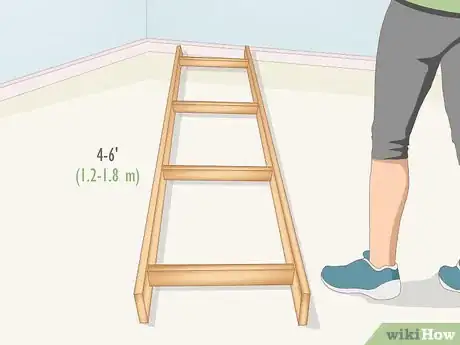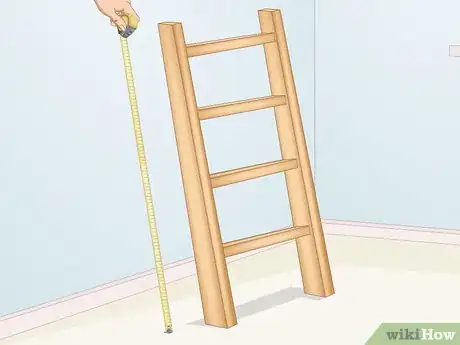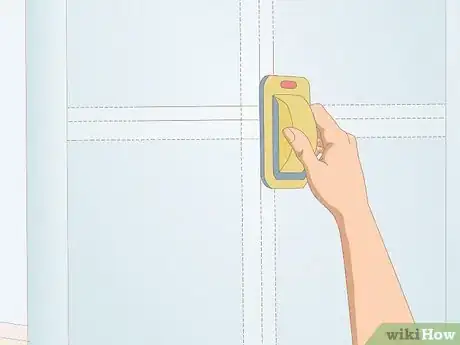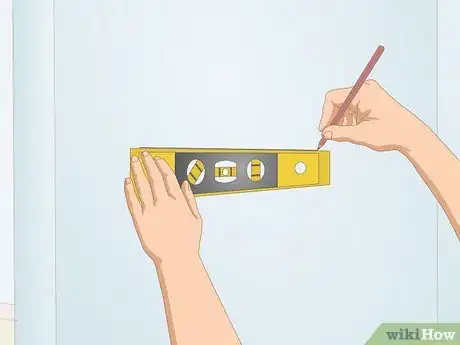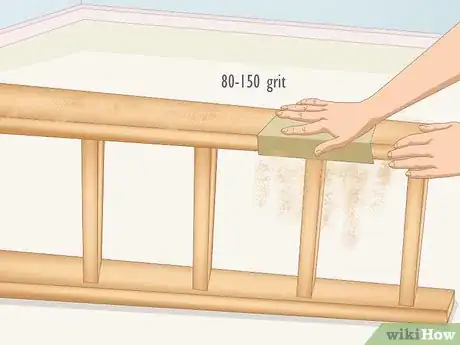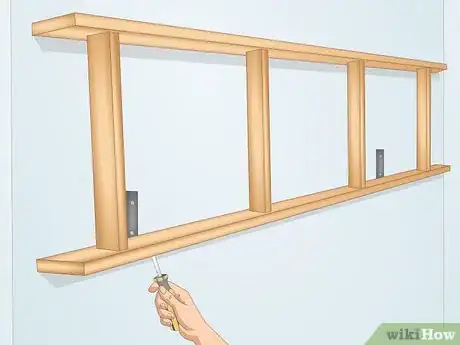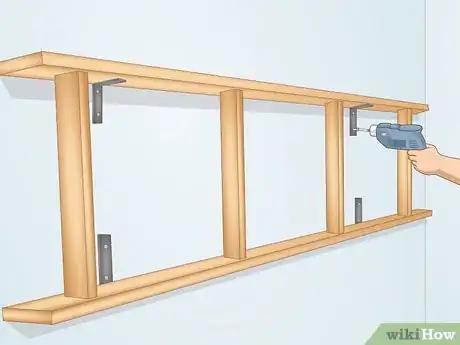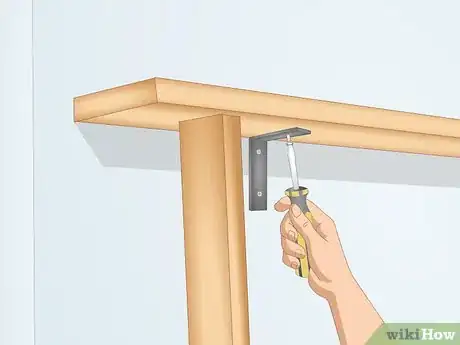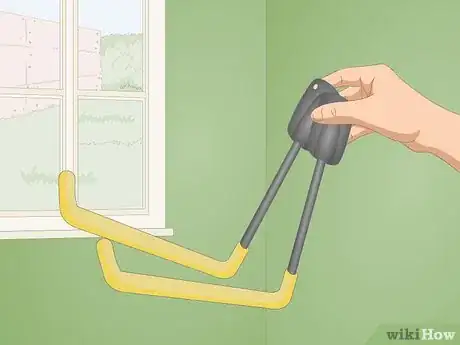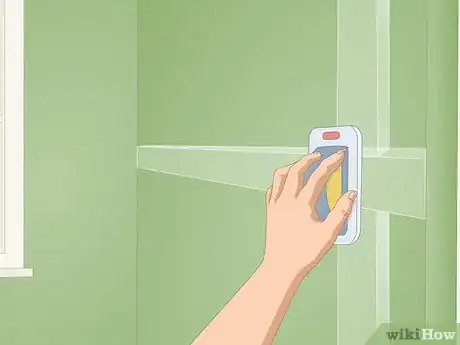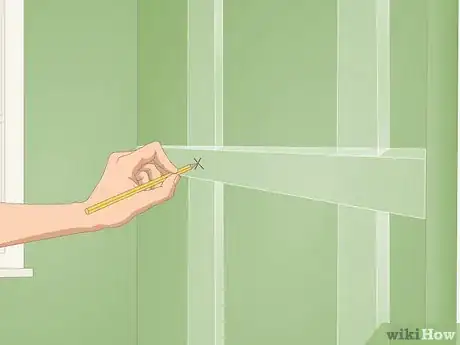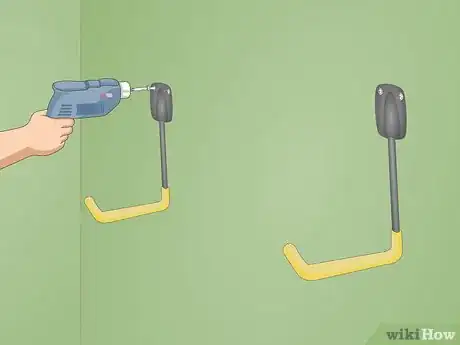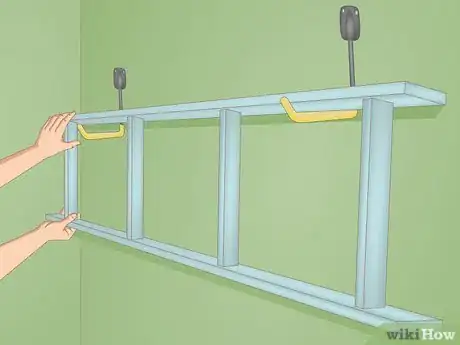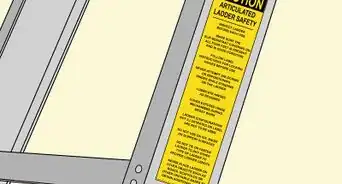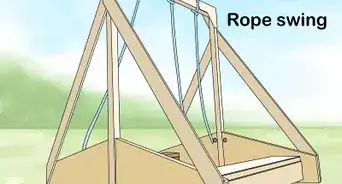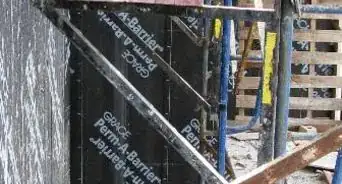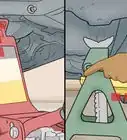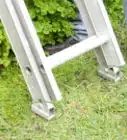This article was co-authored by Christopher Lanier and by wikiHow staff writer, Eric McClure. Christopher Lanier is a handyman and the owner and operator of Watson & Company Handiworks, a handyman business in Austin, Texas. With over three years of experience, Christopher specializes in outdoor light installation, furniture assembly, TV mounting, and window treatment installation. Christopher holds a Bachelor’s degree in Business Administration from the University of Texas at Austin. Watson & Company Handiworks is rated as a Top Pro by Thumbtack.
There are 10 references cited in this article, which can be found at the bottom of the page.
This article has been viewed 27,813 times.
Hanging a ladder on a wall is pretty easy, even if you don’t have much experience with power tools. To hang a ladder for decorative purposes, get L-brackets to support your ladder on the wall. Install L-brackets for the bottom rail before mounting the ladder. Then, install a second set of brackets under the top rail. To store a ladder on a wall to save space, get a set of ladder storage hooks from your local construction supply store. Locate studs in your wall using a stud finder and use a level to mark the location for each hook. Install your hooks so that there are at least 2 hooks supporting your ladder.
Steps
Hanging a Ladder for Decorative Purposes
-
1Purchase a 4–6 ft (1.2–1.8 m) hanging, shelf, or blanket ladder. Get a wooden ladder with 2 rails that is designed for accessing tall bookshelves, hanging off of the side of a wall, or shelving blankets. A standard A-frame ladder isn’t ideal for decoration because it has 4 side rails instead of 2, and you would need to disassemble it to mount it as a shelf or storage unit.[1]
- Even if you do disassemble an A-frame ladder, the seat will extend past the rails, making it sit unevenly on the wall.
- A ladder with flat rails is better than a ladder with round rails. The round rails are harder to drill into.
- Get a ladder with a beautiful wood grain that matches the interior design of your home.
- The side rails are the long lengths of wood that keep your ladder stable.
-
2Measure the ladder to make sure it will fit in the intended space.[2] Lay the ladder down horizontally along the wall where you’re going to install it. If the fit looks tight, use a measuring tape to measure the length of your ladder. Then, measure your wall space to determine if there’s enough room on your wall for the ladder.Advertisement
-
3Use a stud finder to identify where your joists are located. Ladders are heavy and must be mounted on studs. To find studs in your wall, buy a stud finder. Drag the stud finder across your wall to find the supporting joists behind the drywall. The stud finder will beep or light up when it finds a stud in your wall.[3]
- Studs are usually either 16 inches (41 cm) or 24 inches (61 cm) apart. If you can’t find any studs, try replacing the batteries.
- If you don’t plan on putting anything on your ladder and it weighs less than 20 pounds (9.1 kg), you don’t need to hang the ladder on studs.
-
4Use a level and pencil to mark the bracket locations for the bottom rail. Hold a level against the wall until the bubble in the middle is centered. Then, use your stud finder to mark at least 3 studs. Place one mark every 1–2 feet (30–61 cm) to ensure that the ladder will be evenly supported.[4]
- This is much easier to do if you have help. Consider enlisting a friend or family member to hold the level for you while you mark the wall.
- Hold the ladder up before drilling anything into the wall to ensure that your marks don’t overlap with the rungs of the ladder.
-
5Drill L-brackets into the wall with the brackets facing up. L-brackets are L-shaped pieces of reinforced metal that are used to hang heavy items on a flat surface.[5] Buy L-shaped brackets that are slightly smaller than the width of your ladder’s rails and drill them into the wall at the locations that you marked. Use 3 in (7.6 cm) screws to install your brackets.[6]
- The part of your L-bracket that sticks out should be on the bottom.
- If you’re hanging a small ladder with rails thinner than 3 inches (7.6 cm) in width, 1 1⁄8 in (2.9 cm) brackets will work well.
-
6Sand your ladder with 80- to 150-grit sandpaper if you want a smoother finish. If the ladder is heavily used, you may want to sand the surface of the wood to avoid splintering. Put on protective eyewear, heavy gloves, and grab a sheet of 80- to 150-grit sandpaper. Scrub the surface of your ladder using firm back-and-forth strokes to remove the outer layer of wood.[7]
- You can paint your ladder before mounting it if you’d like. If you do, use a brush to paint the ladder with acrylic paint. Add multiple coats until you’ve achieved the texture and color that you desire, then let it dry completely.
-
7Raise your ladder on top of the brackets and screw the ladder in place. Carefully and slowly lift your ladder up. Place the bottom rail on top of the L-brackets so that it sits flush against the wall.[8] Use 1⁄2–1 in (1.3–2.5 cm) screws to attach the ladder to the part of the brackets sticking out of your wall. Hold each screw in the opening of the bracket and slowly drill the screw into the wood using the lowest power setting. Repeat this process for each bracket.[9]
- Ask a friend or family member to brace the ladder while you do this. If you can’t get any help, use your nondominant hand to hold the ladder still after you’ve punctured the ladder with your screw.
-
8Drill additional brackets into the wall under the top rail. Install an L-bracket for the top rail directly over each bracket that you installed for the bottom rail. Flip the bracket upside-down so that the piece that extends out of the wall is on top. Hold the brackets underneath the top rail so that they’re flush under the ladder and wall. Use your 3 in (7.6 cm) screws to drill them into the wall.[10]
- Installing the top brackets after you’ve finished the bottom brackets will ensure that your ladder is fitted perfectly on both sides.
-
9Secure the top rail using 1⁄2–1 in (1.3–2.5 cm) screws. Use your shorter screws to attach the top rail to the L-brackets. Hold each screw in place and slowly pull the trigger on your drill to insert the screws into the L-brackets. Once your ladder is secured on the top and bottom, you’re done!
- You can use your horizontal ladder to store books, trinkets, trophies, or clothing.
Storing a Ladder on a Wall
-
1Purchase some ladder hooks from a construction supply store. Ladders are typically hung on ladder hooks, which are special brackets with a platform at the bottom. Measure the width of your ladder on the side across both side rails with a measuring tape. Go to your local home repair or construction supply store. Buy hooks with platforms that are longer than the width of your ladder.[11]
- Purchase 2 hooks if your ladder is shorter than 6 feet (1.8 m). If it’s taller than that, get at least 3 hooks.
- You can hang shorter ladders that weigh less than 25–35 pounds (11–16 kg) vertically. If you want to store your ladder vertically, get 1 hook.
- Make sure that you buy ladder hooks that are designed for storage. There is a different product that is also called a ladder hook used to make climbing a ladder safe. The ladder hooks you need have a flat back so that they sit flush against the wall.
Tip: If you have a massive extension ladder that is bigger than 18 feet (5.5 m), it’s too heavy to mount on a wall. You may be able to hang it from reinforced ceiling joists though.
-
2Find the studs in your wall using a stud finder. Ladders tend to be quite heavy and they need to be hung on the studs in a wall. Purchase a stud finder and turn it on. Run it over your wall to find your studs. The stud finder will make a noise or light up whenever you’ve passed over a stud.[12]
- If you’re mounting the ladder on a concrete wall, you’ll have to drill near the top of each cinderblock in the center. Mounting a ladder on concrete is not recommended though, as you’ll need to drill deep into the wall, which could weaken it.
- If you don’t have a stud finder, you can often find studs by knocking on the wood with your knuckle. The wall will sound hollow and empty when you’re knocking on drywall with nothing behind it. Studs will sound hard and make a flatter noise.
-
3Label each stud you want to drill into by marking it with a pencil. So long as there is at least 1 hook for every 6 feet (1.8 m) of ladder, it doesn’t necessarily matter which studs you drill into. Set your ladder on the floor against the wall where you’re going to hang it. Using a pencil, mark the wall 2–3 feet (61–91 cm) from the left end of the ladder. Then, label the opposite side, 2–3 feet (61–91 cm) from the right end of the ladder.[13]
- If you’re using 3 or more hooks, space them out so that your ladder is supported evenly across all of the hooks.
- Use a level to adjust the location of each pencil mark so that it’s parallel with the floor. You don’t need to worry about this if you’re storing your ladder vertically. It’s also not particularly important if you’re only using 2 hooks since the rungs will catch the hooks in the corners if they’re a little crooked.
-
4Drill the hook into the wall using 2.5 in (6.4 cm) screws. With the hook flush against the wall, insert a 2.5 in (6.4 cm) screw into the opening at the top of the hook. Hold the hook steady with the side of your nondominant hand while using your fingers to steady the screw. Starting on the lowest power setting, drive the nail through the stud with your drill. Continue drilling until the screw is flush with the hook.[14]
- If your hook has 2 holes that are on different sections of the hook, 1 of the screws won’t be resting in a stud. To solve this problem, grab a 1–2 feet (30–61 cm) sheet of solid wood and drill it into the stud. Then, mount your hook on top of the wood instead of directly on top of your studs.
- If your hooks have 2 screw holes, drive a screw through each opening to completely secure it to the wall.
- If you’re installing hooks in a concrete wall, get a wall plug that is designed to hold screws in masonry. Use a diamond drill bit to create a pilot hole before screwing or drilling the plug into the wall. Install your screw into the plug.
-
5Repeat this process for your other hooks. Move to the mark furthest from the first one. Place the hook on top of the stud and use a 2.5 in (6.4 cm) screw to drive it into the drywall. If you’re using a third hook in the middle, lay a level on top of the 2 hooks and check the air bubble in the middle to ensure that your hooks are even. Drill your middle hook into the wall if you’re installing one.[15]
- Skip this step if you’re installing a single hook to store your ladder vertically.
-
6Store your ladder horizontally by sliding the hooks through the middle. To hang your ladder horizontally, hold it near the middle and wrap your hands under the side rails. Lift the ladder up slowly and slide the top rails over the hook. Lower the ladder slowly until the top rails are hanging evenly on the platform of each hook.[16]
- You can store the ladder with the bottom rails sitting on top of your hooks, but you’ll need to install a second set of hooks 1–2 feet (30–61 cm) above your current hooks so that the ladder doesn’t slide off.
-
7Place your ladder vertically by hanging the seat on the hook.[17] To hang your ladder vertically, close the side rails together and lock them in place if your ladder has a latch on the side. Hold the ladder upright with the seat at the top. Lift the ladder up and hang the seat of the ladder on top of the hook. Let it down slowly to ensure that your ladder doesn’t rip the hook out.[18]
- If your ladder’s seat sits at an angle when you close the rails together, orient the ladder so that the seat points up away from the wall.
- Do not store a ladder vertically with the seat at the bottom. The rails furthest from the wall will eventually come unhinged and swing away from the hook.
Expert Q&A
Did you know you can get expert answers for this article?
Unlock expert answers by supporting wikiHow
-
QuestionHow do you hang a ladder in a garage?
 Christopher LanierChristopher Lanier is a handyman and the owner and operator of Watson & Company Handiworks, a handyman business in Austin, Texas. With over three years of experience, Christopher specializes in outdoor light installation, furniture assembly, TV mounting, and window treatment installation. Christopher holds a Bachelor’s degree in Business Administration from the University of Texas at Austin. Watson & Company Handiworks is rated as a Top Pro by Thumbtack.
Christopher LanierChristopher Lanier is a handyman and the owner and operator of Watson & Company Handiworks, a handyman business in Austin, Texas. With over three years of experience, Christopher specializes in outdoor light installation, furniture assembly, TV mounting, and window treatment installation. Christopher holds a Bachelor’s degree in Business Administration from the University of Texas at Austin. Watson & Company Handiworks is rated as a Top Pro by Thumbtack.
Handyman If you would like to hang the ladder horizontally, you can use J hooks (L-shaped hooks). Pre-drill two holes, get your J hooks put in there, and then hang the ladder right on those J hooks. If you're thinking of hanging the ladder vertically, you can use a larger J hook or one that's got two prongs, where you can hang the ladder from the top prong.
If you would like to hang the ladder horizontally, you can use J hooks (L-shaped hooks). Pre-drill two holes, get your J hooks put in there, and then hang the ladder right on those J hooks. If you're thinking of hanging the ladder vertically, you can use a larger J hook or one that's got two prongs, where you can hang the ladder from the top prong.
Warnings
- Do not use flat brackets to store a ladder. The ladder can slide off too easily and may crush someone or damage your belongings.⧼thumbs_response⧽
Things You’ll Need
Hanging a Ladder for Decorative Purposes
- Ladder
- Drill
- Measuring tape
- Pencil
- Stud finder
- Sandpaper (optional)
- Screws
- L brackets
Storing a Ladder on a Wall
- Measuring tape
- Ladder hooks
- Pencil
- Level
- Screws
- Drill
References
- ↑ https://youtu.be/HQmCJfYeXVU?t=100
- ↑ Christopher Lanier. Handyman. Expert Interview. 25 August 2020.
- ↑ https://www.bobvila.com/articles/how-to-use-a-stud-finder/
- ↑ http://www.oprah.com/homemadesimple/how-to-make-a-ladder-bookshelf-video
- ↑ Christopher Lanier. Handyman. Expert Interview. 25 August 2020.
- ↑ http://www.oprah.com/homemadesimple/how-to-make-a-ladder-bookshelf-video
- ↑ http://www.oprah.com/homemadesimple/how-to-make-a-ladder-bookshelf-video
- ↑ Christopher Lanier. Handyman. Expert Interview. 25 August 2020.
- ↑ http://www.oprah.com/homemadesimple/how-to-make-a-ladder-bookshelf-video
- ↑ http://www.oprah.com/homemadesimple/how-to-make-a-ladder-bookshelf-video
- ↑ https://youtu.be/FqhgUS7et_s?t=9
- ↑ https://www.bobvila.com/articles/how-to-use-a-stud-finder/
- ↑ http://www.oprah.com/homemadesimple/how-to-make-a-ladder-bookshelf-video
- ↑ https://youtu.be/FqhgUS7et_s?t=61
- ↑ https://www.ccohs.ca/oshanswers/safety_haz/ladders/storage.html
- ↑ https://youtu.be/b3HBX2Uyr14?t=519
- ↑ Christopher Lanier. Handyman. Expert Interview. 25 August 2020.
- ↑ https://youtu.be/ojowxX4oXTU?t=20
